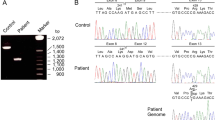Abstract
Bardet-Biedl syndrome (BBS) is an autosomal recessive disorder predominantly characterized by obesity, retinal dystrophy, polydactyly, learning difficulties, hypogenitalism and renal malformations, with secondary features that include diabetes mellitus, endocrinological dysfunction and behavioural abnormalities1,2. Despite an initial expectation of genetic homogeneity due to relative clinical uniformity, five BBS loci have been reported, with evidence for additional loci in the human genome3,4,5,6,7; however, no genes for BBS have yet been identified. We performed a genome screen with BBS families from Newfoundland that were excluded from BBS1–5 and identified linkage with D20S189. Fine-mapping reduced the critical interval to 1.9 cM between D20S851 and D20S189, encompassing a chaperonin-like gene. Mutations in this gene were recently reported to be associated with McKusick-Kaufman syndrome (MKKS; ref. 8). Given both the mapping position and clinical similarities of these two syndromes, we screened MKKS and identified mutations in five Newfoundland and two European-American BBS pedigrees. Most are frameshift alleles that are likely to result in a non-functional protein. Our data suggest that a complete loss of function of the MKKS product, and thus an inability to fold a range of target proteins, is responsible for the clinical manifestations of BBS.
This is a preview of subscription content, access via your institution
Access options
Subscribe to this journal
Receive 12 print issues and online access
$209.00 per year
only $17.42 per issue
Buy this article
- Purchase on Springer Link
- Instant access to full article PDF
Prices may be subject to local taxes which are calculated during checkout


Similar content being viewed by others
Accession codes
References
Beales, P.L., Elcioglu, N., Woolf, A.S., Parker, D. & Flinter, F.A. New criteria for improved diagnosis of Bardet-Biedl syndrome: results of a population survey. J. Med. Genet. 36, 437–446 (1999).
Green, J.S. et al. The cardinal manifestations of Bardet-Biedl syndrome, a form of Lawrence-Moon-Bardet-Biedl syndrome. N. Engl. J. Med. 321, 1002–1009 (1989).
Carmi, R. et al. Use of a DNA pooling strategy to identify a human obesity syndrome locus on chromosome 15. Hum. Mol. Genet. 4, 9–13 (1995).
Kwitek-Black, A.E. et al. Linkage of Bardet-Biedl syndrome to chromosome 16q and evidence for non-allelic genetic heterogeneity. Nature Genet. 5, 392–396 (1993).
Leppert, M. et al. Bardet-Biedl syndrome is linked to DNA markers on chromosome 11q and is genetically heterogeneous. Nature Genet. 7, 108–112 (1994).
Sheffield, V.C. et al. Identification of a Bardet-Biedl syndrome locus on chromosome 3 and evaluation of an efficient approach to homozygosity mapping. Hum. Mol. Genet. 3, 1331–1335 (1994).
Young, T.-L. et al. A fifth locus for Bardet-Biedl syndrome maps to 2q31. Am. J. Hum. Genet. 64, 900–904 (1999).
Stone, D. et al. Mutation of a gene encoding a putative chaperonin causes McKusick-Kaufman syndrome. Nature Genet. 25, 79–82 (2000).
Woods, M.O. et al. Genetic heterogeneity of Bardet-Biedl syndrome in a distinct Canadian population: evidence for a fifth locus. Genomics 55, 2–9 (1999).
Bear, J.C. et al. Inbreeding in outport Newfoundland. Am. J. Med. Genet. 29, 649–660 (1988).
Davidson, W.S. Testing the waters. Biotech. Focus 2, 13–14 (2000).
David, A. et al. Hydrometrocolpos and polydactyly: a common neonatal presentation of Bardet-Biedl and McKusick-Kaufman syndromes. J. Med. Genet. 36, 599–603 (1999).
Schaap, C., ten Tusscher, M., Schrander, J.J., Kuijten, R.H. & Schrander-Stumpel, C.T. Phenotypic overlap between McKusick-Kaufman and Bardet-Biedl syndromes: are they related? Eur. J. Pediatr. 157, 170–171 (1998).
Agashe, V.R. & Hartl, F.-U. Roles of molecular chaperones in cytoplasmic protein folding. Semin. Cell Dev. Biol. 11, 15–25 (2000).
Gutsche, I., Essen, L.-O. & Baumeister, W. Group II chaperonins: new TRiC(k)s and turns of a protein folding machine. J. Mol. Biol. 2, 295–312 (1999).
Katsanis, N. et al. Delineation of the critical interval of Bardet-Biedl syndrome 1 (BBS1) to a small region of 11q13, through linkage and haplotype analysis of 91 pedigrees. Am. J. Hum. Genet. 65, 1672–1679 (1999).
Katsanis, N., Yaspo, M.-L. & Fisher, E.M.C. Identification and mapping of a novel human gene, HRMT1L1, homologous to the rat protein arginine N-methyltransferase 1 (PRMT1) gene. Mamm. Genome 8, 526–529 (1997).
Acknowledgements
We thank the families described for cooperation and the Kleberg Genotyping Center for expertise and fluorescent microsatellites. This study was supported in part by a National Eye Institute, NIH, grant EY12666 (N.K.), the Foundation Fighting Blindness (R.A.L., J.R.L.), the Wellcome Trust (P.L.B.), the Kidney Foundation of Canada, the Canadian Medical Research Council and the Janeway Foundation (J.S.G., P.S.P., W.S.D.).
Author information
Authors and Affiliations
Corresponding author
Rights and permissions
About this article
Cite this article
Katsanis, N., Beales, P., Woods, M. et al. Mutations in MKKS cause obesity, retinal dystrophy and renal malformations associated with Bardet-Biedl syndrome. Nat Genet 26, 67–70 (2000). https://doi.org/10.1038/79201
Received:
Accepted:
Issue Date:
DOI: https://doi.org/10.1038/79201
This article is cited by
-
Obstructive Sleep Apnea in Jacobsen Syndrome
Sleep and Vigilance (2019)
-
Hearing loss and renal syndromes
Pediatric Nephrology (2018)
-
Phenotypic variability of Bardet-Biedl syndrome: focusing on the kidney
Pediatric Nephrology (2012)
-
Brain tissue- and region-specific abnormalities on volumetric MRI scans in 21 patients with Bardet-Biedl syndrome (BBS)
BMC Medical Genetics (2011)
-
Ciliopathies: an expanding disease spectrum
Pediatric Nephrology (2011)



